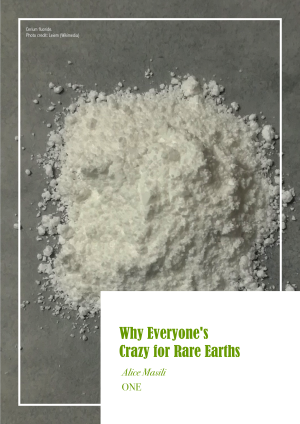 Until recently, hardly anyone knew they existed. Today, everyone is on the hunt for rare earths, the fundamental ingredient for geopolitics, the economy and our technological life in the present and, above all, in the future. Considerable international tensions accompany the scramble for them. Nevertheless, REEs, an acronym for rare earth elements, remain relatively unknown. The priority: creating a recovery and recycling chain.
Until recently, hardly anyone knew they existed. Today, everyone is on the hunt for rare earths, the fundamental ingredient for geopolitics, the economy and our technological life in the present and, above all, in the future. Considerable international tensions accompany the scramble for them. Nevertheless, REEs, an acronym for rare earth elements, remain relatively unknown. The priority: creating a recovery and recycling chain.
Rare earths, often abbreviated as REEs, are a group of 17 chemical elements in the periodic table that belong to the family of metals. More specifically, they are scandium, yttrium, and the 15 lanthanides: lanthanum, cerium, praseodymium, neodymium, promethium, samarium, europium, gadolinium, terbium, dysprosium, holmium, erbium, thulium, ytterbium, and lutetium, in the order of the periodic table.
The attribute ‘rare’ gives the impression that they are scarce, but they are more common than you might think. Geologically speaking, many are not rare at all. Cerium, for example, is as abundant as copper in the Earth’s crust. Others are more abundant than lead, gold or silver. According to recent estimates by the United States Geological Survey (USGS), there are approximately 110 million tonnes of rare earth elements on Earth, sufficient to meet current global demand for three to four centuries.
The historical rarity in the name, therefore, does not refer to their average abundance in the Earth’s crust, but to the low concentration of their deposits and the difficulty of extracting them. There are no rich deposits of rare earths; these elements occur in very low concentrations, scattered and mixed with other metals in rock. To obtain significant quantities of pure rare earths, enormous quantities of rock must be processed. It brings very high mining costs, which in many cases are not economically viable unless they are supported by government subsidies or offset by extremely low labour costs.
Despite their hard-to-pronounce and hard-to-remember names, rare earths are elements that are very present in our daily lives. Until about a hundred years ago, they were practically unknown, but today they are the key to the most advanced technologies. They have unique, truly special properties: extraordinary magnetic, catalytic, optical and electronic properties – characteristics that other elements do not have or do not have to the same extent. And these properties make them irreplaceable, at least as far as current technologies are concerned.
One of the special features that makes these elements so valuable in today’s industry is their ability to exert a magnetism that can withstand even high temperatures. This property makes them indispensable for new-generation technological products. Indeed, rare earths are necessary components for hundreds of products in a wide range of applications. In particular, high-tech consumer products such as smartphones, tablets, PCs, hard drives, rechargeable batteries, electric and hybrid vehicles, monitors, flat-screen televisions and much more. In consumer electronics, flat screens and smartphones elements such as terbium, europium and yttrium are used for brilliant colours. Due to their special properties, such as their outstanding magnetic characteristics, magnets made from these elements are more powerful and lighter than conventional ones. Permanent magnets, the core of car electric engines, are made from neodymium, praseodymium and sometimes dysprosium, for example. Cerium is of fundamental importance for car catalytic converters to reduce emissions.
In addition, the use of these elements is now fundamental in many sectors, such as the aerospace industry, electronics, medicine, petrochemicals, and energy.
With the daily spread of renewable energy sources worldwide, the global demand for rare earths is continuously increasing. Elements such as neodymium and praseodymium, which are used directly in renewable energy technologies and the high-tech industry, are at the centre of interest, especially as electric vehicles and hybrid cars become an increasingly lucrative business. A typical hybrid car can contain around one kilogramme of rare earths, while a 5 MW (Megawatt) wind turbine can contain up to 800 kg of neodymium and 200 kg of dysprosium, totalling 1000 kg of rare earths. However, their strategic importance probably reaches its peak in the military sector. Elements such as holmium and neodymium are crucial to the manufacture of advanced weapons and ballistic systems for armed forces worldwide.
Unlike cars and wind turbines, the number of rare earths in an electronic device, such as a smartphone, is practically insignificant in terms of both weight and volume. Yet without this tiny amount, it would not perform as well as models of the last fifteen years, or perhaps not work at all. Our smartphones are also getting faster and faster thanks to rare earths.
As already mentioned, the reserves of rare earths are spread all over the globe. According to the USGS, China has around 36% of the world’s reserves, followed by Brazil with 21% and Vietnam with 19%, then Russia with 10%, while the remaining 19% is scattered in other countries. The largest deposit in the world is called Bayan Obo and is located in Inner Mongolia. It is an open-cast mine that spans approximately 18 kilometres. Bayan Obo alone accounts for about 50% of China’s rare earth production.
Over the last 30-40 years, China has established an almost absolute dominant position in the entire rare earth value chain. Not only does China hold around 40% of the world’s reserves, but it has also built production and refining facilities near the mines, allowing the extracted raw material to reach them quickly. This clever move, combined with very low labour costs, has made it possible to reduce global production costs. But they have not stopped there. Over the past 15 years, China has expanded its production abroad and secured exclusive extraction rights in Africa in exchange for substantial promises of infrastructure development and construction.
Significant agreements have been signed in the Democratic Republic of Congo and in Kenya, where China committed to provide almost 700 million dollars for the construction of a data centre and a highway.
In general, having a monopoly on a resource means, to some extent, making other countries dependent and, therefore, weaker. The United States government is aware of this, and despite attempts to find a solution, trade tensions with China have escalated. In response to the West’s ongoing tariff sanctions, China began to significantly restrict its exports of rare earths, setting off a chain reaction that led to a supply crisis for US military contractors and the global manufacturing industry. Although attempts were also made to re-export rare earths from other countries, many transport channels to the Usa were completely blocked by China. The United States then attempted to circumvent Chinese restrictions by importing rare earths through third countries such as Thailand, Mexico and India. However, China discovered these alternative routes and tightened its control of rare earth exports, going so far as to suspend exports to India and blacklist the companies involved.
To address this situation, the United States has launched various initiatives and formed strategic collaborations with Japan, Australia, and India, as a part of enhanced cooperation on critical minerals, aiming to build a complete industrial chain for rare earth supply that is not dependent on China – from extraction to processing to shipping of final products. Australia, which is rich in mineral resources, will be responsible for mining, Japan will provide technical support, India will provide labour, and the United States will coordinate the overall structure and investment. Unfortunately, the alliance lacks the crucial link of rare earths refining, which is complex, costly and largely dominated by China.
As a result, China has gradually strengthened its control over its rare earth resources through regulations and strategic policies, consolidating its role in the global supply chain for key minerals.
Alice Masili





